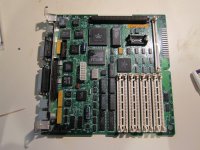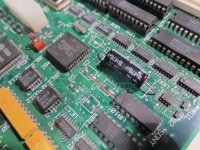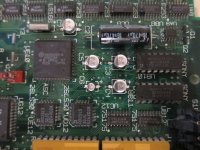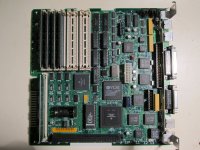LaPorta
Well-known member
While awaiting the SCC chips for my other SE logic board project, I decided to resurrect an SE/30 motherboard that I have had in my possession for a very long time. This came out of my SE/30 probably about 19 years ago. It stopped working somehow (I am no longer sure what the issue was), and on my high school allowance budget, I got a replacement SE/30 board for probably all of $10 at the time on eBay (it was the socketed one, too boot)! I decided to leave this one on the shelf in my room, propped up, as a display piece. There it sat for a good 15 years until I cleaned out my room when my parents moved.
Fast-forward to now, and I looked it over. All surface caps had to go, of course. There was at least one bad trace that ran under C3 and C5 that I repaired. All in all, the board itself was fine otherwise. Green corrosion was scrubbed off with vinegar and a toothbrush. All caps were replaced with organic polymer models so they won't leak in the future. Insert original RAM and ROM SIMM, and, BAM, the thing actually started to gray screen, with pointer (and it moves: ADB mouse moves the pointer without issue. Startup sound via the speaker.
Unfortunately, that is all it does: gray with the pointer, no blinking floppy. Reading my Mac Classic & SE Pina book, it seems as this happens when the Mac has bad SCSI signals (likely via a bad SCSI chip). For all I know, this is what the issue was when I replaced it all those years ago, I simply cannot remember. I'm going to check all the SCSI chip traces in case that is what it is, although so far they all seem to be good. Mouser had replacements, so that's a good thing. Regrettably, I have never done hot air/surface mount soldering other than caps before....so I may have to buy a surface re-work station. Before getting the SCSI chips, any other suggestions as to what may be wrong?
As an aside, I used my copper foil tape to advantage fixing that trace. I coated the trace in solder, taped the coper tape over it, applied heat so that it would bond to the trace. Works perfectly. I then used liquid electric tape to coat and insulate it. I've included pictures of that as well, it really is a pretty visually appealing way to fix a straight trace.
First photo is of the board before repair. Second is of the trace repaired with the foil. Third is the liquid tape over the trace repair. Fourth is the repair with the caps over it. You can see it blends in very well, you might not even notice. Fifth and final is the board so far with new caps installed.





Fast-forward to now, and I looked it over. All surface caps had to go, of course. There was at least one bad trace that ran under C3 and C5 that I repaired. All in all, the board itself was fine otherwise. Green corrosion was scrubbed off with vinegar and a toothbrush. All caps were replaced with organic polymer models so they won't leak in the future. Insert original RAM and ROM SIMM, and, BAM, the thing actually started to gray screen, with pointer (and it moves: ADB mouse moves the pointer without issue. Startup sound via the speaker.
Unfortunately, that is all it does: gray with the pointer, no blinking floppy. Reading my Mac Classic & SE Pina book, it seems as this happens when the Mac has bad SCSI signals (likely via a bad SCSI chip). For all I know, this is what the issue was when I replaced it all those years ago, I simply cannot remember. I'm going to check all the SCSI chip traces in case that is what it is, although so far they all seem to be good. Mouser had replacements, so that's a good thing. Regrettably, I have never done hot air/surface mount soldering other than caps before....so I may have to buy a surface re-work station. Before getting the SCSI chips, any other suggestions as to what may be wrong?
As an aside, I used my copper foil tape to advantage fixing that trace. I coated the trace in solder, taped the coper tape over it, applied heat so that it would bond to the trace. Works perfectly. I then used liquid electric tape to coat and insulate it. I've included pictures of that as well, it really is a pretty visually appealing way to fix a straight trace.
First photo is of the board before repair. Second is of the trace repaired with the foil. Third is the liquid tape over the trace repair. Fourth is the repair with the caps over it. You can see it blends in very well, you might not even notice. Fifth and final is the board so far with new caps installed.






